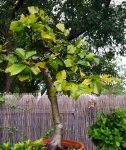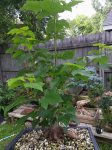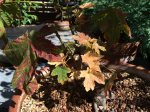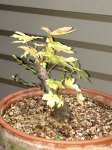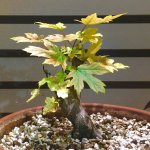You are using an out of date browser. It may not display this or other websites correctly.
You should upgrade or use an alternative browser.
You should upgrade or use an alternative browser.
Under-used\under-rated plants
- Thread starter Nigel Black
- Start date
Leo in N E Illinois
The Professor
- Messages
- 11,341
- Reaction score
- 23,294
- USDA Zone
- 5b
@aml1014 - Your teacher's Acer negundo (box elder) is best I've ever seen with this species. Also demonstrates problem with this species. Notice branches remain somewhat coarse, with no fine branching. The size of this tree makes up for this, so this tree looks good, but clearly the species is not one for shohin or kifu size bonsai.
aml1014
Masterpiece
Definitely not for smaller bonsai, the leaves reduce very well, but not that good!lol I'll get pics of all of her negundo next week. I've got a few and I like them so far, I can tell that it'll be awhile until they are nice.@aml1014 - Your teacher's Acer negundo (box elder) is best I've ever seen with this species. Also demonstrates problem with this species. Notice branches remain somewhat coarse, with no fine branching. The size of this tree makes up for this, so this tree looks good, but clearly the species is not one for shohin or kifu size bonsai.
Aaron
jcrossett
Chumono
Not sure if I missed it or its not usable. And anyone tried "ninebark" I think that's what it was
Leo in N E Illinois
The Professor
- Messages
- 11,341
- Reaction score
- 23,294
- USDA Zone
- 5b
Not sure if I missed it or its not usable. And anyone tried "ninebark" I think that's what it was
I've seen them used. Big leaves and coarse branching on the "standard" varieties. Look for one of the dwarfs. There is a purple leaf nice bark with leaves a quarter the size of the leaves of 'Diablo" that looks like it has good potential.
Txhorticulture
Chumono
First pinyon pine. Just slow and hard to find. Some species aren't extremely cold hardy.
The guayacan is a texas endemic. A broadleaf flowering evergreen that has tiny foliage that looks like a conifer. Only nursery I know of that has carried it says it hardly grows in containers. But is vigorous and durable planted in solid caliche clay.
http://www.texasbeyondhistory.net/ethnobot/images/guayacan1.html
The guayacan is a texas endemic. A broadleaf flowering evergreen that has tiny foliage that looks like a conifer. Only nursery I know of that has carried it says it hardly grows in containers. But is vigorous and durable planted in solid caliche clay.
http://www.texasbeyondhistory.net/ethnobot/images/guayacan1.html
Last edited:
Giga
Masterpiece
10-brink
Mame
nice nebari on that red maple. I'm interested to see how that almond tree turns out.
Decoy Octopus
Yamadori
I've been keeping my eyes peeled for a Mexican Plum at local nurseries. I've seen a few and think it might work well. Still waiting on the right one though. . .
My Jack pines are pinus banksianaUnder Utilized tree species for bonsai - as said early in the thread, what ever is locally native. I've spent way too much time with species not native to my climate, and all the problems with learning how to winter them. I won't give them up, but there is a lot to be said in favor of trees native to your own climate.
My candidates for Zone 5b
Jack Pine - Pinus bungeana - I love having a pine I merely have to put under the bench for winter. Does not need much shelter at all. Mine are still seedlings, 2nd year and 5th year seedlings, so still a long road ahead, but they are behaving nicely. Back buds up and down the young trunks. I don't think they back bud much once mature, so like with other pines, get the branches while young, and use them later when it is time to design.
American persimmon - Diospyros virginiana - another hardy tree, and they develop a nice black checked bark while still under 2 decades old. Fruit is bigger than the frost tender Princess Persimmon, D. rhombifolia, and the Princess persimmon has a smooth bark that never gets very rough. Fruit of D. virginiana is much smaller than the culinary D.kaki, so it does work for medium size bonsai. First year or two seedlings are not as winter hardy as one might hope for, but once they are 3 or 4 years old their hardiness improves. I have some seed that just sprouted, some 2 years, 4 years and 5 years, and one that was planted in the ground 12 years ago and has been bearing fruit since it was 7 years old. I'm fond of eating the fruit. Originally didn't think of them for bonsai until recently, when I saw bark developing on the 12 year old.
Local native elms, I think I have "rock elm", or maybe it is "cedar elm", and of course American elm. All are good and very hardy.
Ostrya virginiana - hop flowered horn beam - much easier than Carpinus caroliniana - tolerates more sun, heat, lower humidity and dry soils better than the "true" American hornbeam. Bark has a different look, but is quite nice, even though not as smooth as Carpinus. Very winter hardy. My seedlings are in their 3rd and 6th growing seasons. Some are approaching "pre-bonsai" and will be ready to be styled soon.
Bur Oak - is the locally native oak with a nice texture bark. Unfortunately mature specimens are hard to collect. I have a couple seedlings, and so far so good. They grow fast, back bud after a chop, and otherwise seem to be okay for bonsai culture. And are super hardy, again minimal winter protection.
There really are too many to list, the above have no issues that may thwart bonsai attempts.
Species that may have problems that may thwart bonsai attempts - so if you try the below - be aware you may be fighting a battle.
Robinia psuedoacacia - Black locust - I love the bark of mature trees, and the flowers, but I have had trouble keeping them going in pots. In a pot they are not that winter hardy, even though in the ground they seem fine.
Witch hazel, and American Filberts or American Hazel nuts. - The leaves don't seem to want to reduce.
Our native Acer - all have problems with either long leaf petioles and large leaves or problems with getting fine ramification. Sugar maple is one I truly love the autumn colors of.
Ash trees - also seem to have coarse branching.
Black willow - Salix nigra - I thought these would be easy, but have not proven to be. Lots of die back issues. They grow fast, almost too fast. Black bark and golden branches is attractive.
M. Frary
Bonsai Godzilla
Or pinus jackus if you know Latin like I do.pinus banksiana
But that's what the 9 billion growing here are I believe.
Giga
Masterpiece
nice nebari on that red maple. I'm interested to see how that almond tree turns out.
I've had it for a few years now - I have a thread about it somewhere and it's getting a pot this spring.
augustine
Chumono
Here's 2 easy ones that I do not see used, but I grow them.
Porcelainberry, the cultivated variety "Elegans." This is a slow grower and not invasive like the ones everywhere in this region. Beautiful foliage, develops a gnarly nebari on its own and great berries this time of the year. Vigorous and easy to grow. Got mine from Bill Valavanis.
Japanese or Purple Beautyberry (Callicarpa dichotoma) vigorous and beautiful berries. this takes a little work to train but you get to enjoy a beautiful shrub in the interim (grow the trunk, prune drastically, choose leader and wire). Also from Bill Valavanis' annual catalog.
Porcelainberry, the cultivated variety "Elegans." This is a slow grower and not invasive like the ones everywhere in this region. Beautiful foliage, develops a gnarly nebari on its own and great berries this time of the year. Vigorous and easy to grow. Got mine from Bill Valavanis.
Japanese or Purple Beautyberry (Callicarpa dichotoma) vigorous and beautiful berries. this takes a little work to train but you get to enjoy a beautiful shrub in the interim (grow the trunk, prune drastically, choose leader and wire). Also from Bill Valavanis' annual catalog.
Leo in N E Illinois
The Professor
- Messages
- 11,341
- Reaction score
- 23,294
- USDA Zone
- 5b
My Jack pines are pinus banksiana
Ooops - I meant Pinus banksiana - is the correct scientific name for Jack pine.
for some reason accidentally typed the species name for Chinese Lacebark Pine - Pinus bungeana. By the way, in theory, they make good bonsai, but I have never seen it used in the USA. I suppose if one were to use Lacebark pine, it would be best as a fat trunk, 3 or 4 foot tall tree, because the only good feature is the flaking bark,
Waltron
Chumono
Walt Paul told me he buys them 100 at a time, and if you have them alive in some sort of container for over a year, you are doing well. im 3/3 on jack pine collecting, so far.. its only been 3 months though. wonder what it is that makes pinus banksiana so difficult? like seriously, does anyone know?
quote below from Mr Paul.
"P. banksiana is styled exactyl like a Scots Pine. Most if these whotd be literati trees. I purchase such trees in large quantities, like one hundred at a time if you have them alive for more than one year in some sort of container".
quote below from Mr Paul.
"P. banksiana is styled exactyl like a Scots Pine. Most if these whotd be literati trees. I purchase such trees in large quantities, like one hundred at a time if you have them alive for more than one year in some sort of container".
thumblessprimate1
Masterpiece
Owen Reich
Shohin
- Messages
- 335
- Reaction score
- 1,125
Ooops - I meant Pinus banksiana - is the correct scientific name for Jack pine.
for some reason accidentally typed the species name for Chinese Lacebark Pine - Pinus bungeana. By the way, in theory, they make good bonsai, but I have never seen it used in the USA. I suppose if one were to use Lacebark pine, it would be best as a fat trunk, 3 or 4 foot tall tree, because the only good feature is the flaking bark,
There are a few Pinus bungeana out there as bonsai. I have a few in the works; also just bought 2 pounds of seed. If anyone has one or has worked with them, please PM me as I'm researching techniques to train them. My best one was in a grow bed for a few years and a deer ate all the needles off. Now it has twice as many branches
The key for bark exfoliation seems to be exposure to sunlight. I've owned 5 of the cultivars, but the graft unions have always been rough. 'Silver Ghost' seems the most appealing of cultivars, with 'Rowe Arboretum' being the least.
M. Frary
Bonsai Godzilla
Their love of sand and not having their roots messed with. Makes it hard to work roots down and get them into bonsai type soil. On the ones I've collected I'm gradually working bonsai soil into the sand. I've repotted it once. I pulled it out of the nursery bucket I put it in at time of collection and just shook about a quarter of the sand off. I then put it into a cut down 5 gal.hydraulic oil bucket with holes bored in it all over. I didnt cut any roots but it had grown a profusion of them. I put bonsai soil into the bottom of the bucket and worked a bunch in and around the outer edge.wonder what it is that makes pinus banksiana so difficult? like seriously, does anyone know
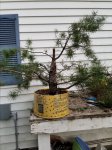 The reason Mr. Pall says most are literati is if left to grow naturally they abandon lower and inner branche's at an early age.
The reason Mr. Pall says most are literati is if left to grow naturally they abandon lower and inner branche's at an early age.I happen to live where there are a few billion. As they sprout seedlings near roads and into ditches (and if they do need heat to open cones why do I find young ones at the edges of plantations?) they get whacked by brush hogs and are kept short. Looking at this one you can see they do back bud.
Next year I try cutting shoots in order to try to force ithe to back bud.
In 2 years I'm pulling it out,shaking more sand off of the roots and reducing them in order to get it into a colander.

parhamr
Omono
Waltron
Chumono
I wonder if there is a good additive we could use to try to imitate their need for sand but still be a good bonsai soil material. think I read Vance uses pool filter sand for his pines? My 3 are about the same situation as yours, except they are in fabric pots, and actually 2 of them have already adapted to fairly small and shallow containers in relation to the size of them which is nice.
Similar threads
- Replies
- 14
- Views
- 557
- Replies
- 21
- Views
- 651
- Replies
- 11
- Views
- 554
- Replies
- 3
- Views
- 477



